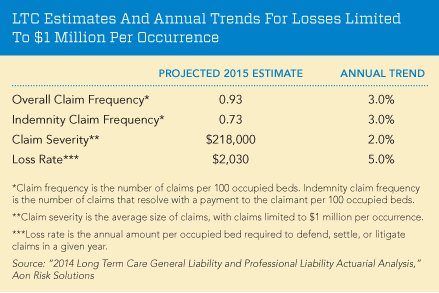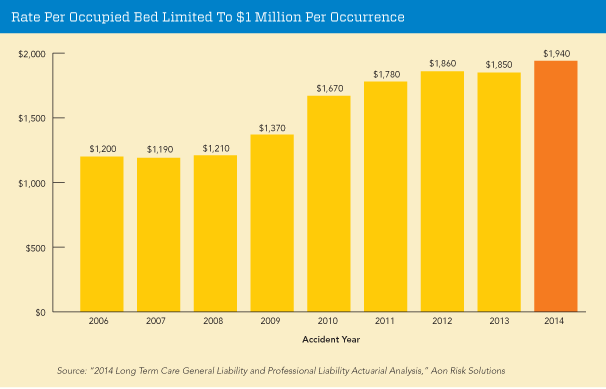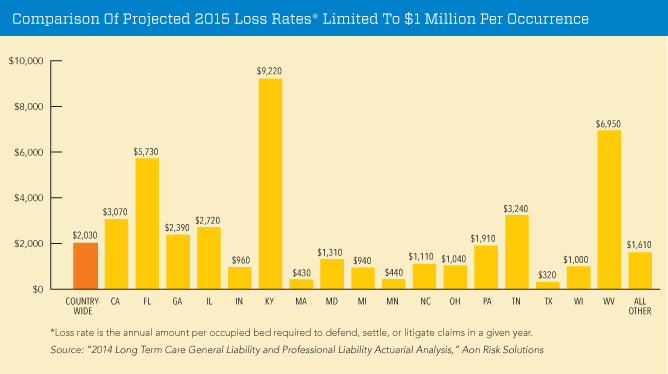
"Lawyers,” Jerry Sterner’s amoral capitalist, Garfinkle, says in “Other People’s Money,” “are like nuclear warheads. They have theirs, so I have mine. Once you use them, they [mess] everything up.”
A bit glib, perhaps, but for a large—and growing—number of providers, no laughing matter. Consider:
■ The average provider can expect to pay some $2,030 per bed this year because of the cost of liability claims to the profession, a 2014 report by Aon Risk Management found;
■ The “loss rate” from plaintiff’s claims will have grown another 5 percent by the end of the year, and claims are increasing both in frequency (3 percent a year) and in severity (2 percent a year), the Aon report says; and
■ The average liability claim is now $218,000, Aon says.
Assured Suits
If that seems bad, don’t worry: Things are actually a lot, lot worse. In Kentucky, for instance—ground zero in the nightmares of most provider advocates—the average provider was projected to have lost $8,790 per bed because of tort cases. That’s more than 14 cents for every Medicaid dollar that comes into a Kentucky care center. A Kentucky provider who is sued can expect to pay more than $450,000, on average, Aon found
“I have either one or two lawsuits pending in Minnesota,” says Paul Killeen, Golden Living’s senior vice president of litigation. “But I have anywhere from three to four times the amount of lawsuits in Kentucky as our number of beds would warrant. Why am I sued all the time in Kentucky and not in Minnesota? Believe me, there’s no material difference between the care in Minnesota and in Kentucky.
“The reason is because Kentucky is a highly advantageous place to do business. They’ll advertise, they’ll gin up people’s feelings of guilt and remorse about their own families, and they will bring lawsuits.”
The harm caused by litigation may be assured, but it’s not mutual. For instance, Reddick Moss Trial Attorneys, a Little Rock, Ark.-based firm, has built its entire business around suing nursing care centers in plaintiff-friendly states such as Kentucky. Its senior partner, Brent Moss, estimates that the firm has reaped more than $100 million in awards over the past decade. Considering the average plaintiff’s lawyer takes anywhere from one-third to nearly half of every award (plus expenses), it’s not hard to find the motivation behind these cases. (“The only thing better than money,” Garfinkle says, “is other people’s money.”
See sidebar.)
‘We Want To Do Our Best’
The argument over tort reform has itself become a kind of mutually assured attack, with each side pouring millions into politics and politicized research to demonstrate the wickedness of the other, without meaningful change on either side.
The sad truth is, sometimes people do get bad care in nursing centers. The sadder truth is that sometimes plaintiffs’ lawyers are the only ones who can rectify the wrongs done to people. But, at its heart, the conflict between plaintiffs’ lawyers and care centers is a business conflict, and an increasing number of provider advocates are hoping that a better way can be found out of the tort standoff.
“If something goes wrong—and we know that sometimes things do—we want to do our best to make families and friends whole,” says Dianne De La Mare, vice president of legal affairs at the American Health Care Association/National Center for Assisted Living. “But when some people build their business by trolling and exploiting people’s sense of guilt, it’s not just businesses that suffer—everyone does.”

Indeed, a 2011 study by the
New England Journal of Medicine found that litigation has only a fleeting relationship with quality of care. Crunching the numbers on thousands of lawsuits, and cross-referencing those suits with government quality ratings, the researchers found that the nation’s centers with the worst government ratings had a 47 percent chance of being sued in a calendar year. Care centers with the best quality ratings had a 40 percent chance of being sued.
“It is far from clear that superior performance will be rewarded with substantially lower risks of being sued,” the researchers say. “Policy moves that are afoot in the long term care sector, such as public reporting of performance indicators and provider payments that are based on performance, may have brighter prospects for making nursing homes safer.”
Friends Don’t Sue Friends
Where, then, can providers find shelter from the nuclear winter?
“I think that the antidote for us is, really, the management of expectations,” Golden Living’s Killeen says. “The populations are Medicaid populations … and all of those people have come there because they have little or no chance of prospering in any other setting. It’s their last home. We’re in a setting in which we have to gain their trust and [that of] their relatives and usher them on to what’s next.”
As Killeen sees it, staff (and, especially administrators) must be “a good tour guide” for families and friends.
“What I’m driving at ... is telling people what to expect and to help them understand that things are not the result of bad choices, but they’re going to happen,” he says. “We need to help people to understand that some of the things that we’re trying to manage as risks are not preventable.”
Killeen sees staff having a conversation that goes something like this: “Your Dad’s had dementia, and he’s had it for two years. Here are the things we want to watch for, and I need your help: One is if he stops eating, because sometimes people forget to eat. How about if you came by a little early and we’ll teach you what to do and you’ll feed Dad?”
Killeen adds, “If I can show people that the folks who work for me are angels who you won’t find in any other business—and they are—then I will push back on the litigation curve. Because friends don’t sue friends.”
Documentation: Is The Pen Mightier Than The Tort?
For Daniel Moriarty, Kindred’s vice president and counsel, care centers also must be beyond diligent in their paperwork.
“In long term care, what really starts the ball rolling is the chart,” he says. “The issue with that is it’s an easy way to create a case where there may not be one otherwise. They can look at the chart and say, ‘Well, look at all these missed entries.’ It gets the companies worried.”
Indeed, Moriarty thinks it’s the seemingly little things that often are the biggest factor in litigation.
“Usually, the families are not upset by wounds, or falls, because they knew that was going to happen anyway. Often, it’s poor customer service—cold food, missing dentures—that drives them into the arms of the plaintiffs’ lawyers.” he says.

Apologies In Fact And In Law
When something does go wrong, though, Moriarty and others are crystal clear: Be open, be honest, and be open and honest, often.
“Get in front and apologize,” he says. “Hiding things only makes it a lot worse when you make a mistake. It’s morally wrong, and it’s not good risk management, either.”
It’s not easy to apologize, Moriarty says. “But it’s the best chance you have of keeping these folks on your side and making them an ally, not an enemy. If you’re successful at keeping lawsuits out of your buildings, it may be because you’ve turned families into allies,” he says.
At least 36 so-called “I’m Sorry” state laws have even given legal encouragement to apologies. In essence, they make expressions of empathy to family members and loved ones (“I feel bad that this happened”) inadmissible in court. And a 2011 study by researchers at Cornell University found that tort claims in such states fell by as much as $73,000 per case.
A Fact Of Life
In the meanwhile, though, every general counsel in the profession is standing at attention.
“When I look at some huge case being settled or a verdict coming down,” Golden Living’s Killeen says, “I don’t, with smug satisfaction, say, ‘That doesn’t happen to us.’ I look at that and say, ‘There but for the grace of God…’ It’s purely the chance outcome of jurors being allowed to be whipped into a frenzy.”
The climax of “Other People’s Money” has a scene that’s almost eerily exact in its symbolism for the conflict between providers and plaintiffs’ lawyers. Andrew ‘Yorgy’ Jorgenson, the naïve but good-hearted steel mill president, looks scornfully upon Garfinkle.
“The robber barons of old at least left something tangible in their wake—a coal mine, a railroad, banks,” Yorgy says. “This man leaves nothing. He creates nothing. He builds nothing. He runs nothing. And in his wake lies nothing but a blizzard of paper to cover the pain.”

Garfinkle’s response is worth repeating. He refers to Yorgy’s speech as “a prayer for the dead.”
“I’m your best friend,” he tells the steel mill shareholders. “I’m your only friend. I don’t make anything? I’m making you money … Because at my funeral you’ll leave with a smile on your face and a few bucks in your pocket. Now that’s a funeral worth having.” In any case, Garfinkle says at the outset of his speech, “It’s too late for prayers.”